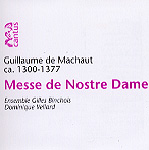There are several excellent recorded versions of Machaut’s mass, which, as one of the great masterpieces of the Middle Ages is a work whose monumental musicological significance is not directly proportional to its comprehensibility for modern listeners. For the best readings, those by the Hilliard Ensemble (Hyperion) and, at budget price, the Oxford Camerata (Naxos), are the mainstays. This superbly sung version joins them–and adds its own valuable insights and rationales as to performance and even to recording location. As always with Dominique Vellard and his Ensemble Gilles Binchois, the historical foundation for the performing editions is solid and sensible. And we can be sure that when we hear the musical effects of Machaut’s “culmination” of the techniques of isorhythm, hoquetus, and syncopation, we are hearing something as close to authentic as can be determined today. It’s often stunning, hearing this work, written in the 1360s, sounding as if it must have come from a much later source. The liner notes explain the performances in some detail–more than many listeners will want, but plenty for serious early music listeners to happily digest. Like the Hilliard Ensemble, these four male voices–countertenor, tenor, baritone, bass–make a sound that’s the vocal equivalent of a matched set of Stradivarius instruments. The tone has bite and strong resonance but blends gorgeously. Early music vocal fans will delightedly recognize the presence of countertenor Andreas Scholl, himself the world’s best in his own solo realm.
The recording lets the voices fill the space while preserving every detail of line and the full harmonic consequence of the open intervals. The venue, the Collegiate of Saint-Martin de Champeaux, was chosen for its “pure and perfect resonance time.” Machaut’s own venue, the Cathedral at Rheims, was not used because of its longer, more “confused” resonance time and because the acoustics in the chapel where he would have originally performed the mass were altered in the 1700s. Incidentally, for a highly idiosyncratic version of this work–a really different listening experience–check out Ensemble Organum’s (Harmonia Mundi) exploration of what they believe to be a more authentic 14th-century performing style, complete with micro-tonal slides, nervous ornamental effects, and a harder-edged vocalism.
































